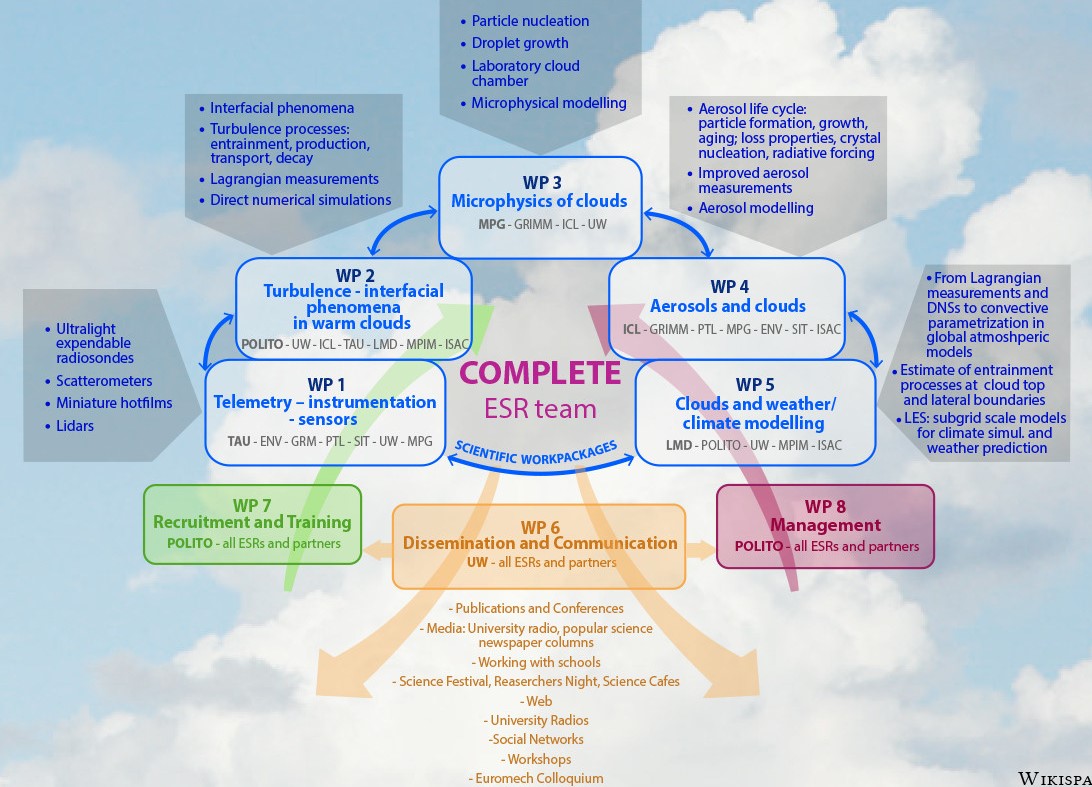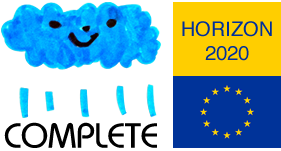Skip to main content

- Telemetry Instrumentation Sensors
WP1 covers research, feasibility and development of telemetry technology. We will develop instrumentation and sensors for the measurement of aerosol and dust particles, water droplets, humidity, turbulent velocity and acceleration in atmospheric and laboratory conditions. T1.1 (MPG, UW), miniature hot and cold wire probes T1.2 (MPG, POLITO, IIT, INRiM), thermometers, thermistors, ultra-light expendable radio-sondes miniature hot and cold wire probes T1.3 (POLITO, ENV, IIT), to measure in-cloud fluctuations of velocity, density, temperature, pressure, water droplet and aerosol concentration (drop- and floating models via scatterometry of optical and IR frequencies). We will also work on the development of remote sensing technology like radars. The in-situ sensors will be biocompatible and for this purpose the biodegradable (e.g. bio-polymer) enclosures with minimum amount of heavy metals will be developed, T1.4 (POLITO, ENV). T1.5 (MPG, ENV, UW), Development of ultrafast temperature, velocity and humidity probes. T1.6 (ENV, UW, TAU) Feasibility analysis for the development of small-scale spectrometers.
- Structure of turbulence in clouds and interfacial turbulent phenomena
WP2 considers turbulence inside clouds. To improve understanding the role of turbulence in cloud processes, information on turbulent velocity fluctuations and on the structure of thermodynamic fields (temperature, humidity and liquid water content) will be analyzed. In particular, we wish to address the following issues: 1) dynamics of turbulent entrainment of dry environmental air into the cloud, 2) microphysical and dynamical effects of turbulent mixing following the entrainment. We will perform high-resolution (~5 cm) numerical simulations in portion of turbulent clouds, T2.1 (POLITO, UW, MPIM); measurements in real clouds, T2.2 (UW, POLITO, ENV, UFS), and in the cloud chamber, T2.3 (UW, TAU) in order to characterize turbulence in warm convective clouds. To set up an open access cloud Lagrangian data base, data will be collected from a) direct numerical simulations of cloud portions performed on massively parallelized energy-efficient supercomputers and b) field measurements by means of expendable smart mini balloons, T2.4 (POLITO, UW, MPG, LMD, ISAC, MPIM, USF). The use of BigData Infrastructure (PICO@Cineca, http://www.hpc.cineca.it/news/pico-cineca-new-platform-data-analytics-applications ) is foreseen.
- Microphysics of warm clouds
WP3 is about experimental and numerical investigation of the main phenomena which govern the microphysics of clouds, like humidity, droplets, growth, size distributions, collision kernels and droplets coalescence. The WP will deal with the controlled laboratory cloud formation (cloud chamber) and infield situation (LiDARs, radars, aircraft based measurements and on-cloud floating radioprobes monitoring). We will study biological particles nucleation of ice at relatively warm temperatures in the atmosphere T3.1 (MPG, UW, ICL, UFS, GRM, TAU, PTL) its influence on microphysical cloud properties T3.2 (MPG, UW, ICL), along with testing of computationally efficient cloud microphysical schemes in convective cloud schemes T3.3 (MPG, UW, POLITO, ICL, LMD, ISAC, MPIM)
- Aerosol and Clouds
WP4 will quantify the dynamics of aerosols and particles in clouds, particularly the differences in dynamics of inertialand non-inertial particles in shear- and buoyancy driven flows. It will analyze Aerosol Life Cycle data to (T4.1, ICL, MPG, UW, POLITO) quantify or develop predictive relationships of important processes in the aerosol life cycle, including new particle formation and growth, aging, loss processes, optical and droplet/crystal nucleating properties,aerosol processing by clouds and direct radiative forcing. Classical and innovative models of nucleation from aerosols will be analyzed and updated with the aim of integrating the process inside advanced numerical simulation codes for cloud microphysics and dynamics. Furthermore, we will test process modeling schemes (T4.2, ICL, MPG) for aerosol concentrations, mixing state, and properties using observational or laboratory data. WP4 will develop improved or new methods (T4.3) to characterize particle size distribution for clouds and aerosols to facilitate unified methods for both clouds and aerosols. WP4 will develop improved measurement methods (T4.4, ICL, MPG, TAU) for aerosol or hydrometeor concentration or properties to fill critical gaps in understanding. Methods to develop or validate classification schemes of aerosol effects on precipitation will be used.
- Clouds and weather/climate modelling
Cloud processes in regional and global climate and weather prediction models remain one of the most important and yet unresolved issues in atmospheric modelling. WP5 aims to transfer the knowledge acquired by the Lagrangian measurements and DNS modelling towards the climate/weather modelling community. T5.1 (LMD, POLITO, MPG, ISAC, MPIG): Modelled Lagrangian trajectories will be estimated from LES (Large Eddy Simulations, resolutions in
the tenth of meters) reproducing conditions of low clouds, stratocumulus and shallow cumulus. T5.2 (LMD, POLITO): The trajectories will then be compared to balloon radioprobe observations. Specific dynamical properties of the balloons will have to be taken into account for the comparison. The aim will be to estimate the entrainment processes at the top and the lateral boundaries of the clouds. T5.3 (LMD, UW, MPIM, ISAC). For the case of stratocumulus probability density functions of downdrafts from the top of the atmospheric boundary layer will be estimated. T5.4 (LMD, UW, MPIM, ISAC): For the shallow cumulus, direct measures and model estimates of mixing rates between cloud and clear air will be obtained. This is critical information for the formulation of shallow convective parameterization in global atmospheric models, if time allows, implementation of the information obtained into the global model will be attempted.
- Dissemination and Communication
According to the Innovation Union strategy we aim at generating an innovation-friendly environment to makes it easier for ITN ideas and achievements to be turned into products and services. Each ESR through the Student Committee SC will provide plans for Dissemination and Outreach activities and collated into a COMPLETE Dissemination and Outreach plan. The NM will collate all publications and outreach resources and make them available on the website. Workshops, Euromech Colloquium and a mini-conference will be facilitated including invited speakers and an opportunity for all ESRs to present.
First task T6.1: Scientific-technical dissemination: organization of Network Workshops, Mini-Conferences and of an Euromech Colloquium on Cloud Microphysics and Dynamics on M46 (2019), participation to International Conferences and Symposia in the fields of Geosciences Multidisciplinary, Physics of the Atmosphere, Telecommunication & Remote Sensing, Instrumentation, Fluid Dynamics, Turbulence. Submission of scientific articles to the main international Journals in these Web of Science Categories (UW coordination, all the beneficiary partners and ISAC, MPIM, USF).
Second Task T6.2: build a structured ITN website (UW, all ESRs).
Third Task T6.3: Use of mass-media (prepare mini-shows on University Radios, e.g. Imperial College Radio, OndeQuadre at POLITO and write on popular science column in regional and national newspapers) (all ESRs, UW, ICL, POLITO, LMD, MPG, TAU, Regione Piemonte). Fourth Task T6.4: blogs on social and professional network (Facebook, Twitter, Linkedin, Research-Gate) (all ESRs). Fifth task T6.5: science exhibitions: European and Local Researchers' Night on the last Friday of the month of September (UW coordination, all ESRs, at least once, September 2017 and 2019), T6.6 production of storytelling revealing the brass-tacks secrets of the ITN research and mini-shows, by using only inexpensive materials, to the general public (inclusive of all ages, from primary school children to elderly pensioners) and amateur experimenters how the ITN COMPLETE ESRs make original discoveries and conceive new technologies. Storytelling and mini-shows to be the presented in classrooms, school and municipal libraries, municipal museums. Associated videos to be posted on You Tube (UW, all ESRs and host institutions - each ESR participating to a minimum of two events during their recruitment periods, I3P, RAMOT, UFS, BayFOR, RP). Last but not least, seven task T6.7: Foster, Lead and Manage the transfer of ITN COMPLETE new technologies from the laboratory to the marketplace and participate to the Regional Innovation Monitor Plus (RIM Plus) platform (I3P, RAMOT).
- Recruitment and Training
T7.1 Recruitment. The Supervisory Board will manage the recruitment process. Once all ESRs are in post, a report will summarize the recruitment process, gender balance, origin and completion of the declarations of conformity, and initial Training Needs analysis and Career Development plans. Overseen by Recruitment & Equal Opportunities Officer. All beneficiary partners involved.
T7.2 Agree and implement guidelines on high standards of supervision. Best-practice for supervision and training will be
agreed using the EC Charter guidance and diversity and equality training based on the Athena-Swan process. A guideline document will be created by the Coordinator and Director of Training (DoT) to include the roles, responsibilities and procedures for supervisors and mentors in the personal and professional development of the ESR (POLITO, ICL, LMD, MPG, TAU, UW, ENV, SIT).
T7.3 Development of the ITN Training Programme. The DoT will oversee the timetabling and course development of the Training Programme outlined above (Section 2) with support of the Network Manager and host based skills trainers. The COMPLETE website will list available courses and timing. Opportunities for intersectorial visits and secondments to exchange knowledge with the member of the network will be evaluated and ESRs and hosts supported by the NM in organizing the intersectorial visits and secondment periods (POLITO, all partners).
T7.3. Local host training of ESRs and Network Opportunities, in particular training through research by means of individual, personalized project, including exposure to different sectors. ESRs will be registered for a PhD by a host - organization and participate in local training. The DoT and NM will oversee the Local Training. The NM and Hosts will build a Network resource of local course materials including study aids, videos and on-line tutorials (WIKISPACE). Supervisors and ESRs will work with the NM to identify ITN or other opportunities when required skills not available locally are identified. All ESRs will be encouraged and supported in attending further courses outside the network (POLITO, all Partners).
T7.4 Network-wide Training Events exploiting the inter/multi-disciplinary and intersectorial aspects of the project and expose the ESRs to different schools of thought. The proposed network training events will be coordinated by the NM who with the DoT ensure the course development is timely and of high standard utilizing appropriate resources within the ETN. The NM will support participants with the logistics of attending Network-wide Training Events (POLITO, all Partners).
T7.5 Invitation of visiting Researchers originating from the academic or non-academic sector. To improve the skills and know-how of the ESRs, as well as their scientific writing, personal development, team skills, multicultural awareness, gender issues, ethics and research integrity (POLITO).
T7.6 Training related to research and innovation: management of IPR, take up and exploitation of research results, communication, standardization, entrepreneurship, enterprise start-up, task co-ordination, training related to management or grant searching (I3P, RAMOT).
T7.7 EU Proposal writing and project management (BayFOR)
T7.8 Formulation of the Career development plans for all the recruited ESRs: identification of long and short term objectives, of the research and complementary skills to be developed during the training period, and of the main results expected as a consequence of the research carried by the ESRs during their training. (all participants)
- Project Management
Administrative project management, reviewing the overall project progress, the timely delivery of milestones and deliverables planned as well as necessary reporting. Communication with REA/European Commission will also fall in this WP.
T8.1. Coordination: A Consortium Agreement (CA) will be signed by all partners including agreed roles and responsibilities, financial distribution of grant funding, and Intellectual Property rules. The coordinator will ensure reporting obligations are met; efficient distribution of grant funding; liaise with the EC; and organise a mid-term assessment.
T8.2. Management. The Project Management Team (PMT) will support the Supervisory Board. Roles and Responsibilities have been clearly established including decision making, conflict resolution, communication channels, ethical and gender aspects, monitoring of progress and risk and reporting processes. Project data will be collated and archived.
T8.3. Intellectual Property Rights. An Exploitation Plan will be prepared at the end of M6 and updated at annually by the Exploitation and IP Committee (EI) led by Exploitation Manager (EM). The EM will monitor IP and convene EI meetings as required. Exploitation Plans will be used as case studies in Complementary Skills sessions to help the ESRs to see the relevance of this activity.

